Birds of Passage
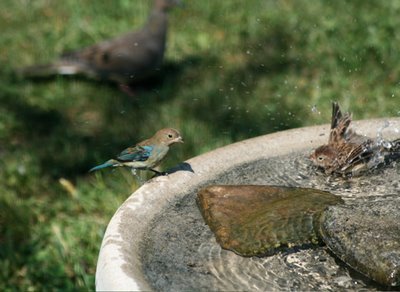 A molting juvenile male indigo bunting gets a shower from a field sparrow.
A molting juvenile male indigo bunting gets a shower from a field sparrow.They’re gone, almost all gone, the birds of passage. Every year, the Big Sit rolls around, and it seems uncannily timed for the moment that the last warbler of autumn quits the place entirely. Sure, we usually see the first junco of the year on Big Sit Sunday, but many of the birds that peopled (or birdled) our trees only two days earlier are gone like a puff of smoke.
The nights have turned cold lately, finally. It feels final, anyway. It feels like time to haul plants into the greenhouse . It feels like time to take the last desperate measures to propagate plants whose cuttings didn’t root, or give it up and dig them up and bring them in as mother plants. It feels like time to get the garden cart and load it up with tropical mandevillas and bougainvilleas and grunt it down the side hill to the Garden Pod. Time to fire up the little gas heater in there and bask in warmth. I am thinking these thoughts, this same person who was cursing the 90-degree days just a couple of weeks ago.
And I've spent the entire day outside in the first nice weather for what seems like two weeks, hauling plants and digging geraniums, planting a serviceberry my friend Cindy gave me two years ago, planting a daylily Margaret gave me for my birthday, planting the beautiful blue rose of Sharon I got at Chautauqua, planting two propagules of the heirloom lilac bush. I've pulled the pond pump and drained the filter and taken it all inside. I've drained the hoses and taken them in, too. I've cleaned the Spa and made sure it's bubbling furiously so as not to freeze. I've filled the feeders again. I've mowed the lawn for the last time (I hope) and I can hear the growl of the weed whacker as Bill trims the long hair around the beds and edges. I'm going to go out before dark and cover the huge red mandevilla with a sheet, maybe drape some sheets over the salvia beds. I brought in the Pig of Good Fortune, who is made of terra cotta and who is slowly sloughing away, nose first, and found the cellophane of a monarch chrysalis that had hatched out, affixed to his belly. Good fortune, indeed.
My legs and back ache and I'm tired to the bone, a good tired. It's a good thing it's getting dark; I'm collapsing. The greenhouse is bursting with beautiful flowers in fresh new pots and it's all clean and sunny in there and it makes me look forward to the winter, to know I have it to go to when I'm needing a dose of green and fragrant things. I filled it last week and put some more plants in there today. I think I've got everything I'll need for the winter...heliotrope, mandevilla, hibiscus, impatiens, fuchsia, geraniums, my big ol' cacti, the jade tree with a trunk as big around as my arm, my rosemary tree...on and on. It's lovely in there.
The Carolina chickadees are looking sleek in their new winter plumage. As Mary has pointed out, this is a hard bird to get in the frame, much less in focus. Ahhh, Mary. Are you ready for your new Digital Rebel yet? Ooh, I love to tease you, especially with chickadee pictures. Once you get your new camera, you'll try to catch the highlight in a chickadee's eye, instead of trying just to catch the chickadee. Easier said than done!
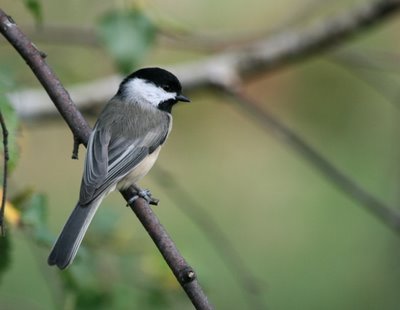
Looking back at the birds of passage: I photographed what's probably the last indigo bunting in the Spa on October 12. This is a gorgeous first-year male, just coming into winter plumage. It reminds me very much of the cordon bleu finch of Africa (and aviculture).
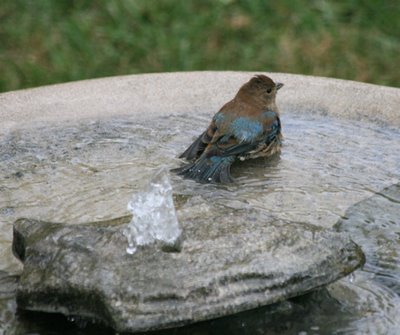 Immature male indigo buntings undergo an extra molt in the fall that gives them some blue nuptial plumage. Most birds would travel to the wintering grounds in first basic plumage. It's an energetically expensive thing to do, so there must be a reason for it, right? It's thought to perhaps confer competitive advantage on the wintering grounds, where they're fighting mature males for territory. But we don't know that for sure.
Immature male indigo buntings undergo an extra molt in the fall that gives them some blue nuptial plumage. Most birds would travel to the wintering grounds in first basic plumage. It's an energetically expensive thing to do, so there must be a reason for it, right? It's thought to perhaps confer competitive advantage on the wintering grounds, where they're fighting mature males for territory. But we don't know that for sure.Chipping sparrows have massed and largely departed, making way for the juncos and tree sparrows. They appreciate our wild “lawn,” studded with crabgrass of many kinds. The nice thing about crabgrass if you’re a bird is that it makes so many little seeds, and it heads out so quickly that there are always crabgrass dinners available. The nasty thing about crabgrass if you like a neat lawn is exactly the same thing. Good thing I look at crabgrass as chippy food. Here’s a little klatsch of chippies under the Bird Spa, going at the seedheads. Love it!
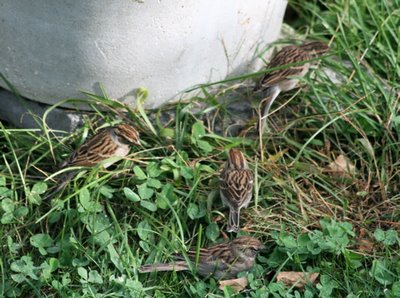
One from the seed eating bunch flew up briefly to perch in my studio birch. I really like this shot. Such a pretty little sparrow.
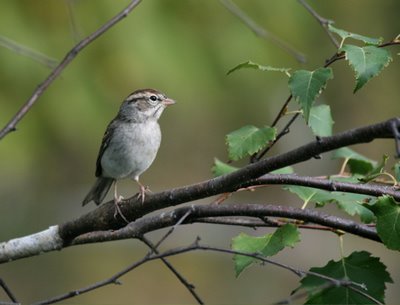 I miss them when they leave, and I’m so happy when they come back in April. Something to get me through the winter. I'll be saving hair clippings all winter for them to weave into their nests come April.
I miss them when they leave, and I’m so happy when they come back in April. Something to get me through the winter. I'll be saving hair clippings all winter for them to weave into their nests come April.Labels: Bird Spa, Carolina chickadee, chipping sparrows, indigo bunting






<< Home